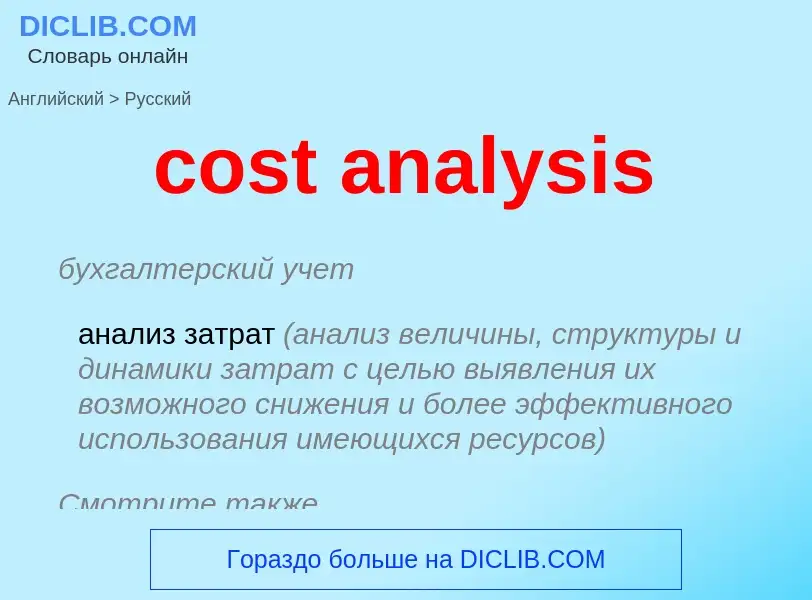Перевод и анализ слов искусственным интеллектом ChatGPT
На этой странице Вы можете получить подробный анализ слова или словосочетания, произведенный с помощью лучшей на сегодняшний день технологии искусственного интеллекта:
- как употребляется слово
- частота употребления
- используется оно чаще в устной или письменной речи
- варианты перевода слова
- примеры употребления (несколько фраз с переводом)
- этимология
cost analysis - перевод на Английский
бухгалтерский учет
анализ затрат (анализ величины, структуры и динамики затрат с целью выявления их возможного снижения и более эффективного использования имеющихся ресурсов)
Смотрите также
Определение
Википедия
Cost–benefit analysis (CBA), sometimes also called benefit–cost analysis, is a systematic approach to estimating the strengths and weaknesses of alternatives. It is used to determine options which provide the best approach to achieving benefits while preserving savings in, for example, transactions, activities, and functional business requirements. A CBA may be used to compare completed or potential courses of action, and to estimate or evaluate the value against the cost of a decision, project, or policy. It is commonly used to evaluate business or policy decisions (particularly public policy), commercial transactions, and project investments. For example, the U.S. Securities and Exchange Commission must conduct cost-benefit analyses before instituting regulations or deregulations.: 6
CBA has two main applications:
- To determine if an investment (or decision) is sound, ascertaining if – and by how much – its benefits outweigh its costs.
- To provide a basis for comparing investments (or decisions), comparing the total expected cost of each option with its total expected benefits.
CBA is related to cost-effectiveness analysis. Benefits and costs in CBA are expressed in monetary terms and are adjusted for the time value of money; all flows of benefits and costs over time are expressed on a common basis in terms of their net present value, regardless of whether they are incurred at different times. Other related techniques include cost–utility analysis, risk–benefit analysis, economic impact analysis, fiscal impact analysis, and social return on investment (SROI) analysis.
Cost–benefit analysis is often used by organizations to appraise the desirability of a given policy. It is an analysis of the expected balance of benefits and costs, including an account of any alternatives and the status quo. CBA helps predict whether the benefits of a policy outweigh its costs (and by how much), relative to other alternatives. This allows the ranking of alternative policies in terms of a cost–benefit ratio. Generally, accurate cost–benefit analysis identifies choices which increase welfare from a utilitarian perspective. Assuming an accurate CBA, changing the status quo by implementing the alternative with the lowest cost–benefit ratio can improve Pareto efficiency. Although CBA can offer an informed estimate of the best alternative, a perfect appraisal of all present and future costs and benefits is difficult; perfection, in economic efficiency and social welfare, is not guaranteed.
The value of a cost–benefit analysis depends on the accuracy of the individual cost and benefit estimates. Comparative studies indicate that such estimates are often flawed, preventing improvements in Pareto and Kaldor–Hicks efficiency. Interest groups may attempt to include (or exclude) significant costs in an analysis to influence its outcome.

![French engineer and economist [[Jules Dupuit]], credited with the creation of cost–benefit analysis French engineer and economist [[Jules Dupuit]], credited with the creation of cost–benefit analysis](https://commons.wikimedia.org/wiki/Special:FilePath/Julesdupuit.jpg?width=200)
